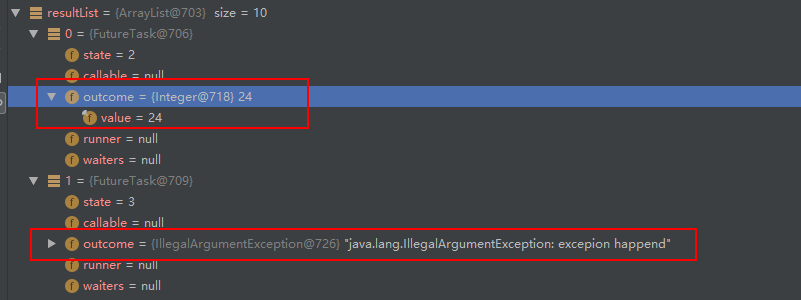本文介绍如何向线程池提交任务,并获得任务的执行结果。然后模拟 线程池中的线程在执行任务的过程中抛出异常时,该如何处理。
一,执行具体任务的线程类
要想 获得 线程的执行结果,需实现Callable接口。FactorialCalculator 计算 number的阶乘,具体实现如下:
1 importjava.util.concurrent.Callable;2 importjava.util.concurrent.TimeUnit;3
4 /**
5 * Created by Administrator on 2017/9/26.6 */
7 public class FactorialCalculator implements Callable{8
9 privateInteger number;10
11 publicFactorialCalculator(Integer number) {12 this.number =number;13 }14 public Integer call() throwsException {15 int result = 1;16
17 if (number == 0 || number == 1) {18 result = 1;19 }else{20 for (int i = 2; i < number; i++) {21 result *=i;22 TimeUnit.MICROSECONDS.sleep(200);23 if (i == 5) {24 throw new IllegalArgumentException("excepion happend");//计算5以上的阶乘都会抛出异常. 根据需要注释该if语句
25 }26 }27 }28 System.out.printf("%s: %d\n", Thread.currentThread().getName(), result);29 returnresult;30 }31 }
上面23行--25行的if语句表明:如果number大于5,那么 if(i==5)成立,会抛出异常。即模拟 执行5 以上的阶乘时,会抛出异常。
二,提交任务的Main类
下面来看看,怎样向线程池提交任务,并获取任务的返回结果。我们一共向线程池中提交了10个任务,因此创建了一个ArrayList保存每个任务的执行结果。
第一行,首先创建一个线程池。第二行,创建List保存10个线程的执行结果 所要存入的地方,每个任务是计算阶乘,因此线程的返回结果是 Integer。而这个结果只要计算出来了,是放在Future里面。
第5-7行,随机生成一个10以内的整数,然后创建一个 FactorialCalculator对象,该对象就是待执行的任务,然后在第8行 通过线程池的submit方法提交。
1 ThreadPoolExecutor executor =(ThreadPoolExecutor) Executors.newCachedThreadPool();2 List> resultList = new ArrayList>();3 Random random = newRandom();4 for (int i = 0; i < 10; i ++) {5 int rand = random.nextInt(10);6
7 FactorialCalculator factorialCalculator = newFactorialCalculator(rand);8 Future res = executor.submit(factorialCalculator);//异步提交, non blocking.
9 resultList.add(res);10 }
需要注意的是:submit方法是个非阻塞方法,参考这篇文章。提交了任务后,由线程池里面的线程负责执行该任务,执行完成后得到的结果最终会保存在 Future里面,正如第8行所示。
As soon as we invoke the submit() method of ExecutorService the Callable are handed over to ExecutorService to execute.
Here one thing we have to note, the submit() is not blocking.
So, all of our Callables will be submitted right away to the ExecutorService, and ExecutorService will decide when to execute which callable.
For each Callable we get a Future object to get the result later.
接下来,我们在do循环中,检查任务的状态---是否执行完成。
1 do{2 //System.out.printf("number of completed tasks: %d\n", executor.getCompletedTaskCount());
3 for (int i = 0; i < resultList.size(); i++) {4 Future result =resultList.get(i);5 System.out.printf("Task %d : %s \n", i, result.isDone());6 }7 try{8 TimeUnit.MILLISECONDS.sleep(50);9
10 } catch(InterruptedException e) {11 e.printStackTrace();12 }13 } while (executor.getCompletedTaskCount() < resultList.size());
第3-6行for循环,从ArrayList中取出 每个 Future,查看它的状态 isDone() ,即:是否执行完毕。
第13行,while结束条件:当所有的线程的执行完毕时,就退出do循环。注意:当线程在执行过程中抛出异常了,也表示线程执行完毕。
获取线程的执行结果
1 System.out.println("Results as folloers:");2 for (int i = 0; i < resultList.size(); i++) {3 Future result =resultList.get(i);4 Integer number = null;5
6 try{7 number = result.get();//blocking method
8 } catch(InterruptedException e) {9 e.printStackTrace();10 } catch(ExecutionException e) {11 e.printStackTrace();12 }13 System.out.printf("task: %d, result %d:\n", i, number);14 }
第3行取出每个存储结果的地方:Future,第7行 从Future中获得任务的执行结果。Future.get方法是一个阻塞方法。但前面的do-while循环里面,我们已经检查了任务的执行状态是否完成,因此这里能够很快地取出任务的执行结果。
We are invoking the get() method of Future to get the result. Here we have to remember that, the get() is a blocking method.
任务在执行过程中,若抛出异常,下面语句在获取执行结果时会直接跳到catch(ExecutionException e)中。
number = result.get()

但它不影响Main类线程---主线程的执行。

整个Main类代码如下:
importjava.util.ArrayList;importjava.util.List;importjava.util.Random;import java.util.concurrent.*;/*** Created by Administrator on 2017/9/26.*/
public classMain {public static voidmain(String[] args) {
ThreadPoolExecutor executor=(ThreadPoolExecutor) Executors.newCachedThreadPool();
List> resultList = new ArrayList>();
Random random= newRandom();for (int i = 0; i < 10; i ++) {int rand = random.nextInt(10);
FactorialCalculator factorialCalculator= newFactorialCalculator(rand);
Future res = executor.submit(factorialCalculator);//异步提交, non blocking.
resultList.add(res);
}//in loop check out the result is finished
do{//System.out.printf("number of completed tasks: %d\n", executor.getCompletedTaskCount());
for (int i = 0; i < resultList.size(); i++) {
Future result =resultList.get(i);
System.out.printf("Task %d : %s \n", i, result.isDone());
}try{
TimeUnit.MILLISECONDS.sleep(50);
}catch(InterruptedException e) {
e.printStackTrace();
}
}while (executor.getCompletedTaskCount()
System.out.println("Results as folloers:");for (int i = 0; i < resultList.size(); i++) {
Future result =resultList.get(i);
Integer number= null;try{
number= result.get();//blocking method
} catch(InterruptedException e) {
e.printStackTrace();
}catch(ExecutionException e) {
e.printStackTrace();
}
System.out.printf("task: %d, result %d:\n", i, number);
}
executor.shutdown();
}
}
在上面 number = result.get(); 语句中,我们 catch了两个异常,一个是InterruptedException,另一个是ExecutionException。因为我们是在main线程内获得任务的执行结果,main线程执行 result.get()会阻塞,如果在阻塞的过程中被(其他线程)中断,则抛出InterruptedException。
若在任务的执行过程中抛出了异常(比如IllegalArgumentException),那么main线程在这里就会catch到ExecutionException。此时,就可以对抛出异常的任务“进行处理”。此外,线程池中执行该任务的线程,并不会因为 该任务在执行过程中抛出了异常而受到影响,该线程 可以继续 接收并运行 下一次提交给它的任务。
图中 task1、task2、task4 返回的结果为空,表明它们抛出了IllegalArgumentException异常。
参考资料
《Java 7 Concurrency Cookbook》 chapter 4
原文:http://www.cnblogs.com/hapjin/p/7599189.html




















 2396
2396











 被折叠的 条评论
为什么被折叠?
被折叠的 条评论
为什么被折叠?








